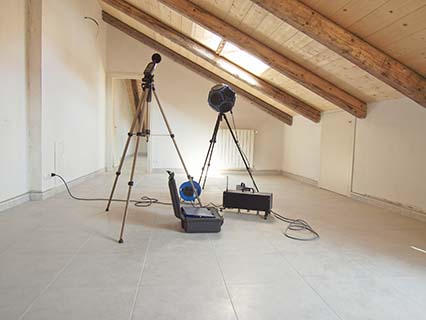Part E of the building regulations requires that buildings are to be tested prior to completion in order to confirm they meet or exceed Part E standards. The person carrying out the building work should arrange for sound insulation testing to be carried out by a test body with approved qualifications and affiliations. All tests are at the Building Inspectors discretion. Failure in the test will result in the sound insulation needing to be improved and the construction type re-tested.
Sound Insulation Testing
What sound testing services do we offer?
AF acoustics offer a range of comprehensive acoustic solutions to customers nationwide, and we guarantee a high-quality and high-efficiency approach. Phone or email us today for more information on how we can help you with your acoustic requirements.

Why do you need a sound test?
Sound Insulation Testing or Sound Testing is normally required when a building has been converted to flats i.e. Material Change of Use or the building has been constructed as purpose built flats e.g. New Build.
Approved Document E of the Building Regulations requires that Party Walls and Floors must be sound tested to prove compliance with the criteria set out within the document table as shown in below.
For walls, Airborne Wall Sound Tests are required. We would need access to both sides of the Party Wall to carry out the sound testing and all windows and doors need to be fitted in order for the sound tests to be completed.
For Party Floors, we would need to carry out Sound Tests for Airborne and Impact Noise between Flats. As before, all windows and doors need to be fitted and working for the Sound Testing to be completed properly.
Airborne Noise
Airborne floor sound insulation tests are carried out with a large speaker or dodecahedron speaker, using a white noise generator to create the source sound, almost always in the largest room of the two rooms under testing. A sound level meter is then used to take noise measurements within the source room and the receiver room (room directly adjacent to the source room). The background noise level is also measured. The higher the background noise then the higher the source noise will need to be set, since the resulting noise level in the receiver room needs to be 10dB higher than the background noise at all measured frequencies.
Impact Sound Testing
When undertaking impact sound tests the tapping machine is placed in the upper apartment or flat and the noise level is measured in the lower apartment or flat in the room under the tapping machine
In all cases the room to be tested should be habitable in nature, i.e. bedrooms or living rooms, and they should have a minimum volume of 25 m³ in order for the sound tests to be carried out correctly.

Should the Sound Tests fail, Building Control should be notified so that they can advise you of how to proceed, since you will need to work out the reason for the sound test failure and what to do about it. AF Acoustics can provide a diagnostic service for Sound Tests that fail including investigations into where unwanted noise is travelling through and the best method to reduce the problem. Please call our office for further details of our consultancy services.
Normally it is cheaper to check that a design will be compliant with the building regulations before commencing the building work. We would be happy to provide this type of consultancy work, and if a design is not of the required standard we would give recommendation to ensure a pass. Please contact our office for more details on how we can be of assistance.
Current noise level limits for houses and flats are:
Table 1: Dwellings-houses and flats – performance standards for separating walls,
separating floors, and stairs that have a separating function.

Table 1b: Rooms for residential purposes – performance standards for separating walls,
separating floors, and stairs that have a separating function.




